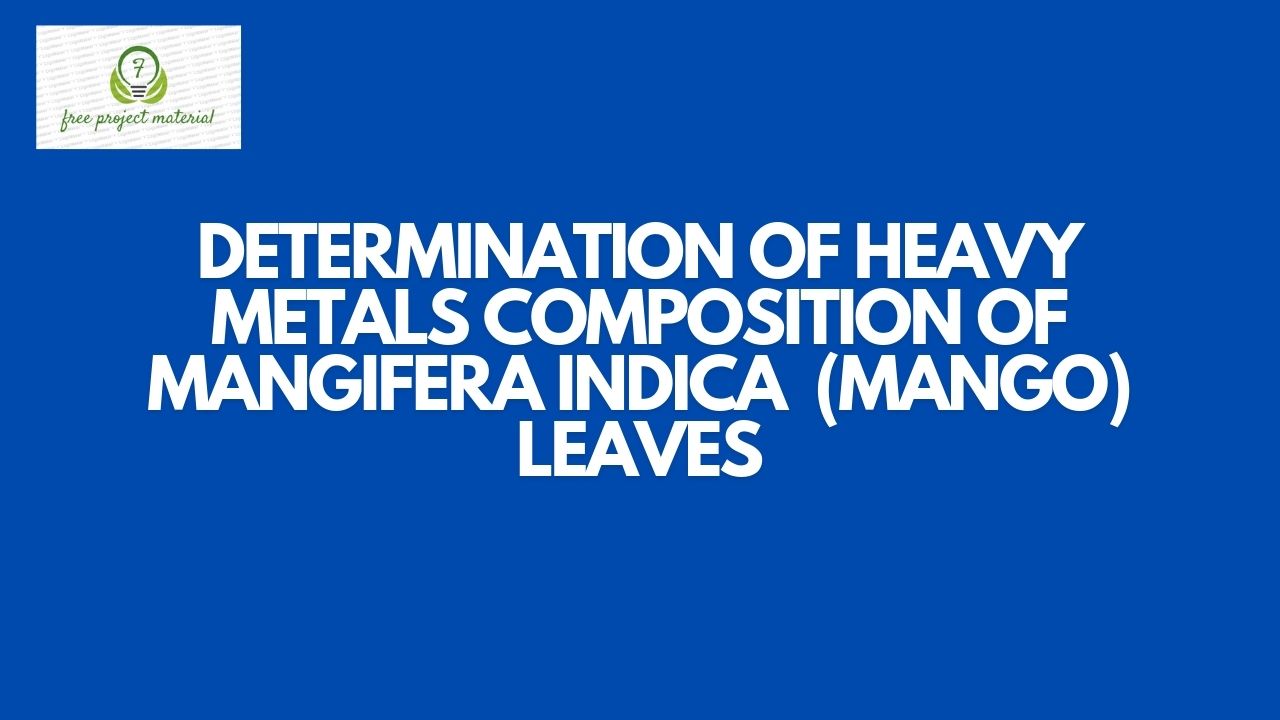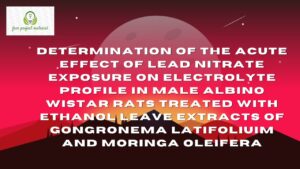ABSTRACT
This study was designed to analyze the heavy metals (Pb, Fe, Cu, Zn, Cd) composition of Mangifera indica (mango) leaf. The samples were analyzed using standard analytical procedure. The result of the analysis in mg/100g revealed the following, Pb (0.17±0.51), Fe (2.45±0.08), Cu (5.11±0.21), Zn (1.02±0.05) and in Cd (<0.01±0.00). The highest concentration of heavy metals in the sample was in copper and the lowest was cadmium. The implication of this results are discussed. Keywords: Heavy metals, composition, mangifera indica, leaves.
TABLE OF CONTENT
PAGES
TITLE PAGE – – – – – – – – i
CERTIFICATION – – – – – – – ii
DEDICATION – – – – – – – – iii
ACKNOWLEDGEMENT – – – – – – iv
ABSTRACT – – – – – – – – v
TABLE OF CONTENT – – – – – – – vi-viii
CHPTER ONE INTRODUCTION
- Background of the Study – – – – – 1-3
- Aim of the Study – – – – – – – 3
- Objectives of the Study – – – – – – 4
- Scope and Limitation of the Study – – – – 4
- Definition of Terms – – – – – – 5
CHAPTER TWO LITERATURE REVIEW
2.1 Description of Mango Plant – – – – – 6-9
2.2 Culinary Uses – – – – – – – 9
2.3 Cuisine – – – – – – – – 10-12
2.4 Types of Heavy Metals – – – – – – 12-13
2.5 Heavy Metals and the Eco- and Biophere – – – 13-16
2.6 Mitigating heavy metals – – – – – – 16-22
2.7 Sources of Heavy metals – – – – – – 22-23
2.8 Factors Influencing Uptake of Heavy metal by plant – 24
2.9 Toxicity of Heavy Metals – – – – – 25-27
CHAPTER THREE MATERIALS AND METHOD
3.1 Materials – – – – – – – – 28
3.2 Sample Collection/Treatment – – – – – 28
3.3 Digestion of Sample – – – – – – 29
3.4 Analysis of Heavy Metals – – – – – 29-30
CHAPTER FOUR RESULTS AND DISCUSSION
4.1 Results – – – – – – – – 31
4.2 Discussion – – – – – – – – 32-33
CHAPTER FIVE
CONCLUSION AND RECOMMENDATION
5.1 Conclusion – – – – – – – – 34
5.2 Recommendation – – – – – – – 34
References
CHAPTER ONE
INTRODUCTION
1.1 Background of The Study
“Heavy metals” are natural elements characterized by their rather high atomic mass and their high density. Although typically occurring in rather low concentration, they can be found all through the crust of our planet. Commonly, a density of at least 5 g cm−3 is used to define a heavy metal and to differentiate it from other, “light” metals. Other, broader definitions for “heavy metals” require an atomic mass higher than 23 or an atomic number exceeding 20; these definitions are highly error prone and confusing. Both alternative definitions cause the inclusion even of nonmetals; resorting to the atomic mass criterion, the maximum number of elements classified as “heavy metals” rockets high to 99 out of the total 118 building blocks of our universe. Looking at the periodic table of elements, we learn that heavy metals sensu strict (according to the density criterion) occupy the lion’s share, namely, columns 3–16, of the periods 4 to 6, encompassing the transition metals, post-transition metals, and lanthanides (Duffus, 2002).
Some heavy metals like copper, selenium, or zinc are essential trace elements, with functions indispensible for various biological processes also driving the entire human metabolism (Mertz, 1981). The heavy metal cobalt, acting as the central atom in the vitamin B12 complex, is a key player in the reductive branch of the propionic acid fermentation pathway (Stowers et al., 2014).
Without this special heavy metal compound, the gourmet would have to do without the unique flavor of Emmentaler cheese. Many heavy metals are of outstanding technological significance, e.g., iron, zinc, tin, lead, copper, tungsten, etc. Recently, different heavy metals act as the central atom of artificially designed “bioinorganic” catalysts for special chemical transformations (Terfassa et al., 2014). Moreover, among them we find precious noble elements like gold, silver, iridium, rhodium, or platinum (Rao and Reddi, 2000).
On the other hand, many of them, e.g., mercury, cadmium, arsenic, chromium, thallium, lead, and others, classically represent the “dark side of chemistry”; they exert toxic effects already at low concentration (Durvibe et al., 2007).
In this context, some heavy metals have gained dubious popularity by being the materials major crimes can be made of heavy metals were literally heaven’s sent by originating from asteroid impacts. Typically, heavy metals occur in the earth’s crust in rather low concentrations between the low values ranges (noble metals) up to 5% (iron), here, heavy metals are mainly found chemically bound in carbonate, sulfate, oxide, or silicate rocks or also occur in their metallic, elemental form. Weathering and erosion resulted in their leaching and mitigation into soil, rivers, and groundwater (Kaiser, 2007).
1.2 Aim and Objectives of the Study
1.2.1 Aim of the Study
The aim of this study was to determine the heavy metal composition in Mangifera indica leaf.
1.2.2 Objectives of the Study
The objectives of the study were:
- To determine the Copper (Cu) composition of Mangifera indica
- To determine the Iron (Fe) composition of Mangifera indica
- To determine the Zinc (Zn) composition of Mangifera indica
- To determine the lead (Pb) composition of Magifera indica
- To determine the Cadmium composition of Mangifera indica
1.3 Scope and Limitation of the Study
The scope of this study only covers the determination of heavy metals composition of Mangifera indica.
The limitation encountered in the course of this study were:
- Time constraint
- Financial constraint
- Poor power supply
- Scanty literature
1.4 Definition of Related Terms
- Heavy Metals : Heavy metals is a metal that has a very high density. The relation of its weight to its volume, such as gold and lead.
- Composition: composition is the different parts which something is made of the way in which the different parts are organized.
- Transformation: Transformation is a complete change in something. The way in which a work is undergone. A process by which an element in the underlying logical deep structure.
- Toxicity: Toxicity is the degree of which a chemical substance or particular mixture of substance can damage an organism.



